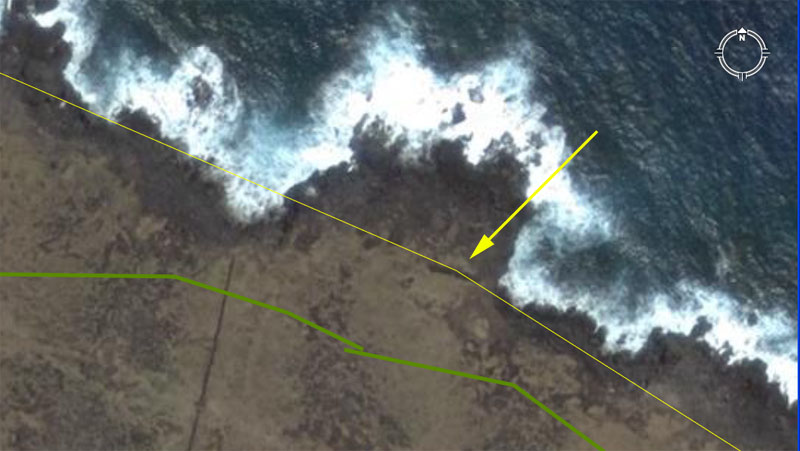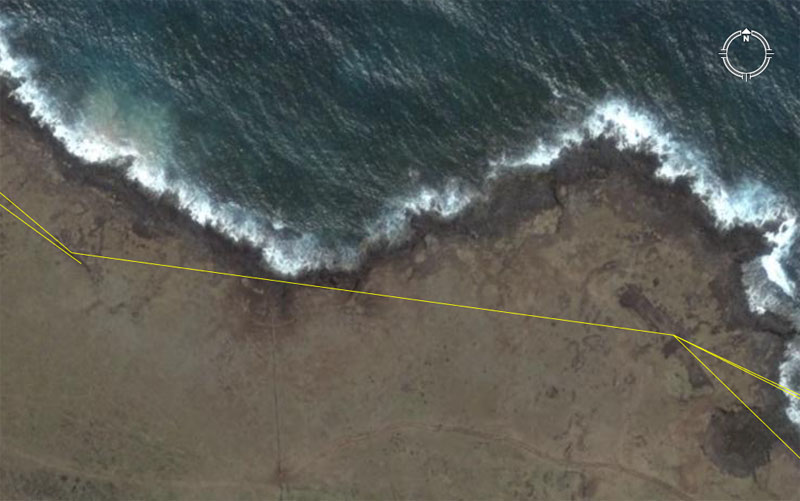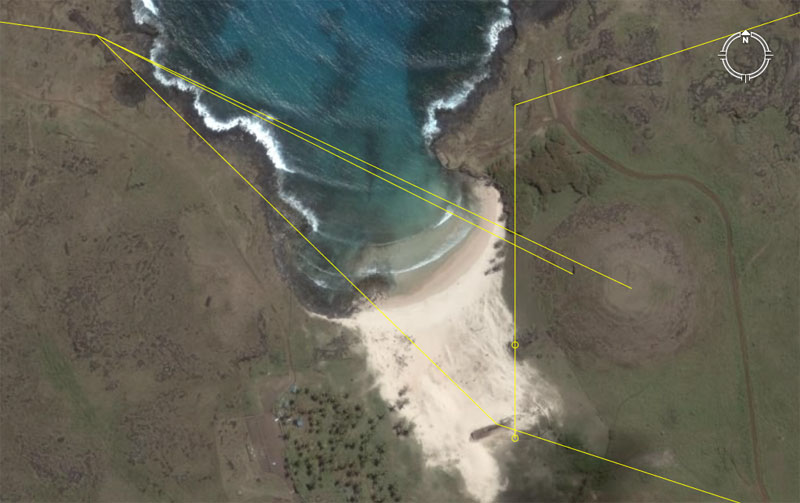ROCK AROUND THE CLOCK
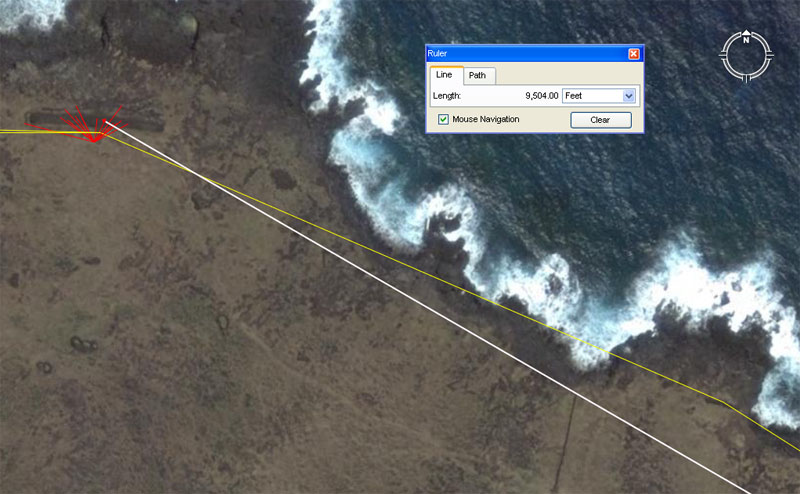
A white line is seen to resolve upon the approximate centre of this simple, isolated ahu situated centrally on the northern coast of Easter Island. The line runs for 9504-feet (navigational code) from the benchmark cleft in the side of Anakena Beach hill at an azimuth angle of 300-degrees or 120-degrees return. The location of this ahu platform would represent the approximate 12 o'clock position of the island.
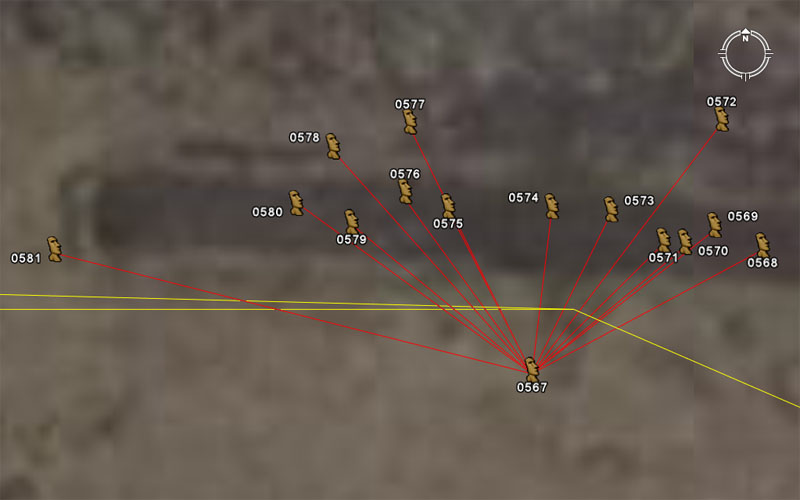
The numbered images shown, which were taken from the Rapa Nui Archaeological Database, plot the positions of individual moai associated with this particular ahu platform (known as AHU NORTH COAST IV). The database gives the precise coordinates for each moai monument shown and so it will now be relatively simple to test each position in relation to another within the confines of the same "classroom".
The outer markers, distributed on and around the ahu platform, are shown to have lines running to them from the hubstone position (moai 0567). Each line shown has been generated in AutoCAD architectural program, based upon the coordinates supplied by the Rapa Nui Archaeological database. Here is the approach taken to the analysis of distances and angles:
Two separate systems of coordinates are seen in the screen image
above. One relates to Google Earth (the background picture, complete with
yellow lines running through it) and the second system based upon the survey
conducted by the Rapa Nui Archaeological Database teams (showing moai images).
There can exist a slight discrepancy or difference in the coordinate readings
of each system, which could mean an offset error of up to 30-feet between
where Google Earth says an object sits and where the Rapa Nui Archaeological
Database says the same object sits.
Despite this difference in readings, we can still achieve excellent relative
accuracy in determining distances and angles between objects by using each
system separately or by overlaying one set of coordinates onto another. If
objects can be seen in Google Earth, then the distance separating them can
be accurately measured in that medium with the Google Earth Ruler tool and
the angle between them accurately fixed in AutoCAD. If they can't be seen
in Google, then one reverts to reading distances and angles of separation
solely in the Rapa Nui Archaeological Database. All due care is being exercised
to achieve the greatest accuracy possible, nevertheless, results derived and
conclusions drawn as to the intended coding of each position by the ancient
architects can be adjusted, if need be, in future analysis. This kind of probe
will tell the reader exactly how the sites were set up very scientifically
to function in teaching principles of navigation and cyclic astronomy and
the values listed are the probable coded values built into each position.
Remember, these sites were deliberately wrecked by malevolent invaders, so
the original positions of marker placement have been jostled somewhat, nevertheless
the original codes should be mostly intact and retrievable, as they recur
constantly on similar sites across the globe.
This is what the codes appear to have been:
(1) 0567 to 0581: The distance is 129.6-feet and the azimuth angle is 104.166666-degrees (104 & 1/6th). There appears to be at least two close proximity markers and one would have, undoubtedly, carried the angle code of 105-degrees.
The value 129.6 relates to the ancient reading of the Precession of the Equinoxes, which was calculated to endure for 25,920-years (360 X 72). The sum of 1296-years would be 1/20th of the period. The value was also very important to navigation and 1296-inches (108-feet) would be 1/7th of the length of the Great Pyramid of Egypt. Alternatively, the length 1296-feet would be 1/100800th of the equatorial circumference of the Earth under the Great Pyramid's literal geodetic assignment (note: 100.8-feet was 1-second of Earth equatorial arc under the Great Pyramid's literal dimension reading).
Whereas the angle of 104 & 1/6th-degrees would have provided very useful values in a mathematical progression related to navigation, the most likely intended coding was 105-degrees. The Hebrew Reed measurement was 10.5-feet or 1/500th of a Greek mile (note: the so-called "Greek" incremental values are found, not only to be present in the measurements of ancient Egypt, but are equally present in the lengths and angles of Neolithic British and Continental European sites ... thousands of years before there was a "Greek" civilisation). A mathematical progression based upon 525 or 105 produces highly important values that relate to both navigation and the lunar periods (The lunar year and the long enduring lunar nutation cycle). The values 525 or 105 were at the foundation of the lunisolar Sabbatical Calendar system shared by Caucasoid cousin nations from remote antiquity, all the way up to the "Calendar of Coligny" brass plaque of Druidic France.
(2) 0567 to 0580: The distance is 75.6-feet and the angle is 126-degrees. The distance is, of course, 1/10th of the length of the Great Pyramid and represents an incremental value in the equatorial circumference of the Earth. The length was encoded in mnemonic recognition of 1/80th of 1-minute of arc of the equatorial circumference. Within the same length there would also be recognition of and a tutorial related to the value 756.25-feet, which was a second way of reading the Great Pyramid's length in accordance with the mile of 5280-feet. Under the literal reading of 756-feet, the Earth was considered to be 24883.2 Greek miles (of 5250-feet each) in circumference. This was the "6&7" family of numbers method of navigating. Under the second reading the Earth was considered to be 24750-miles (of 5280-feet each) in circumference. This was the "11" family of numbers method of navigating (the 5280-feet mile survives in modern times and is still used in the USA).
The angle of 126-degrees is for mnemonic reference to the Hebrew Reed measurement. The Reed of 10.5-feet (1/500th of a Greek mile) is also 126-inches. A Greek foot is 12.6-inches and an Assyrian Cubit is twice that value @ 25.2-inches. The value 126 is one of the most dynamic of antiquity. There would be 6 X 126-feet in the length of the Great Pyramid (756-feet). The length of 126-feet would be 1/48th of 1-minute of equatorial arc under the Great Pyramid's literal geodetic assignment.
(3) 0567 to 0579: The distance is 61.8-feet and the angle is 129.6-degrees. The distance is in homage to a value derived from the PHI ratio, which was absolutely central to the fabrication of precise, round, volume tubs for the market place. Each of the ancient Caucasoid-European cousin nations used the same formula to create code bearing volume vessels, whether ancient Egyptian, Greek, British or whatever. The formula went 10 ÷ 1.6180339 (PHI) = 6.18034. As long as the round bases of market place tubs were fabricated in diameters of 1, 2, 3, 4 or more increases of 6.18034-inches, then the bases gave a perfect square inch reading that complied to one of the "special" numbers. After this sides, also complying to a coded height, were added to the tub base and the final volume dispensed in the marketplace contained a code related to such things as the equatorial circumference of the Earth, the cycles of the moon, the calendar count, etc. The special knowledge could never be lost because it was used on a daily basis by being encoded in the "volume" of the cup one drank from or the tub that one bought grain from in the marketplace. It was also encoded into the "grain" weight of coins or "scale" stones used for weighing out quantities, etc.
An example of how this "tub fabrication" method worked survived till a fairly late era in Britain and, although there was some marginal drift off the earlier precision, the method was preserved in the "Winchester Standard".
The original bushel of England was, undoubtedly, based upon a Sumerian/ Babylonian volume called a Homer, which was 21600 cubic inches. The English Winchester bushel was, originally very close to 6 X 6 X 60 cubic inches (2160 cubic inches...1/10th of a Homer). In ancient England the tub created to measure out a correct bushel volume was described as, "any round measure with a plain and even bottom, being 18.5 inches wide throughout and 8 inches deep". This surviving volume from the old English Winchester Standard, undoubtedly, had a pedigree founded upon older traditions, passed down from distant ancestors. Under the earlier PHI derived method, the base width should have been 3 X 6.18034-inches or 18.54102-inches ... very close to 18 & 7/13ths.
Using the PHI based rendition listed above at 6.18034 inches the final capacity is: 6.18034 X 3 = 18.54102 inches ÷ 2 = 9.27051 (squared) = 85.94235566 X PI = 270 square inches X 8 (the height of the sides extending above the base) = 2160 cubic inches (1.25 cubic feet).
The code contained within this capacity relates to the zodiac and how the sun spends 2160-years in each of the 12 Houses of the Zodiac during the 25920-year cycle of the Precession of the Equinoxes. Every volume vessel of all of the cousin nations did something similar ...
Let's consider some of these:
- 1 Egyptian Theban @ 11664 cubic inches...6.75
cubic feet. A Theban would be 5.4 ancient bushels of 1.25 cubic feet.
- 1 Greek Metretes @ 2332.8 cubic inches...1.35
cubic feet. A Metretes would be 1.08 ancient bushels of 1.25 cubic feet.
- 1 Hebrew Homer @
28512 cubic inches... 16.5 cubic feet. A Homer would be 1.32 ancient bushels
of 1.25 cubic feet.
- 1 Roman Amphora @ 1900.8 cubic inches...1.1 cubic feet. An Amphora would
be .88 ancient bushels of 1.25 cubic feet.
- 1 Babylonian Archane @ 129600 cubic inches...75 cubic feet. An Archane would be 60 ancient bushels of 1.25 cubic feet.
Note: All of the above values are navigational and lunar codes, which will occur in the coded positions of Easter Island, just as they occur at Nazca Peru in the desert geometry or at Avebury Henge in Britain, etc., etc.
The angle of 129.6-degrees that occurs between hubstone 0567 to outer marker 0579 relates to the Precession of the Equinoxes duration and navigation, as explained.
(4) 0567 to 0578. The distance is 78.75-feet and the angle is 138.24-degrees. The code built into the distance is navigational and 78.75-feet would be 75 Greek feet or 1/8th of a Greek Stadia (630-feet). There would be 3.141818182 X 7875-miles in the Great Pyramid's equatorial circumference reading. Note that the value 3.141818182 was one of several special renditions of PI used by ancient navigators to convert linear diameters into perfect circumferences. It was used anytime linear legs of travel at sea were being undertaken according to miles of 5280-feet. By use of this rendition of PI, circumferences generated were sexagesimal and could be read perfectly within a 360-degree environment. By consequence, when linear legs of travel were completed according to "Greek" miles of 5250-feet, the rendition of PI used was 22/7ths. These conversion methods of linear legs of travel being turned into circumferences were for positional plotting on the navigational chart at sea and for always staying abreast of the angle back to the point of departure or onwards to the destination.
The angle of 138.24-degrees is mnemonic for recalling the equatorial size of the Earth. Under the Great Pyramid assignment the Earth was 12 X 12 X 12 X 12 X 1.2 Greek miles in circumference or 24883.2-miles of which 138.24-miles would be 1/180th part. The same formula was used to describe the "true" size of the Earth in miles of 5280-feet, although this method (18.8-miles short of the true circumference) was not very easy to manipulate in actual navigation, so the highly factorable values of 24883.2 Greek miles and 24750 British miles were commonly used by the cousin nations.
(5) 0567 to 0576. Strangely enough, the length from the hubstone out to stone 0576 is 57.6-feet and the angle is 144-degrees. A mathematical; progression based upon 57.6 produces highly important values applicable to navigation, the Precession of the Equinoxes or calendar calculations. The diagonal face length of the Great Pyramid from the base to where the flat floor altar begins was, essentially, 576 feet. The Aubrey circle at Stonehenge has a diameter of 288-feet or half of 576-feet. Under the Great Pyramid's equatorial circumference assignment, there would be 576-Reeds of 10.5-feet each in 1-minute of equatorial arc; there would be 45-periods of 576-years in the 25920-year duration of the Precession of the Equinoxes, etc.
The angle of 144-degrees is also related to 576 in the same numerical progression and 144 X 4 = 576.
(6) 0567 to 0575. The distance is 48.6-feet and the angle is 333.3333-degrees (333 & 1/3rd). A mathematical progression based upon 48.6 produces very important navigational, Precession of the Equinoxes, lunar and calendar numbers. The lunisolar Calendar of Coligny plaque of Druidic France is 4.86-feet in overall length (1 Roman Pace of 58.32-inches). There were two forms of the Roman foot, one of which was strictly for lunar calculations. The lunar foot was 11.664-inches and the overland measuring foot was 11.666666-inches (11 & 2/3rds). Under the 11.664-inch foot the Roman mile (5000 Roman feet) would have equated to 4860 standard feet of 12-inches each. All of the various "feet" were simply calculation increments shared and used by all of the cousin nations and all are in ratio to other "feet" or cubits used.
The angle is simply 1/3rd of 1000. It's probable that this marker was actually set to 153.6-degrees (the opposing angle or 333.6 minus 180-degrees) like marker 0577, which we will now discuss.
(7) 0567 to 0577. The distance is 72.9-feet and the angle is 153.6-degrees. The distance of 72.9-feet would equate to 75 Roman lunar feet of 11.664-inches each. The Bush Barrow Lozenge artefact of Southern England, which dates to about 3000 BC, is 7.29-inches long or 1/8th of a Roman Pace of 58.32-inches (the lozenge predates the Roman civilisation by a few thousand years, so these measurement standards were in place long before the groups they're now attributed to. The 72.9-feet coding is strongly lunar. In the lunisolar Sabbatical Calendar a total of 7.2-lunar years (2551.5-days) were monitored alongside 7-solar years (2556.75-days). There would be 35 intervals of 72.9-days in 2551.5-days. It was highly essential for ancient navigators to be fully conversant with the movements and position of the moon in relation to the Earth, as the moon's gravitational tug on our atmosphere is the biggest determinant of weather conditions. A "bad" moon could mean hurricanes, typhoons or very adverse conditions that would endanger the ship, its crew and precious cargo and the navigator had to predetermine the degree of risk in venturing into certain oceans when the moon was in a potentially dangerous position.
The angle is navigational and the value 153.6, used in a mathematical progression, produces numbers related to the 24883.2-mile equatorial circumference. There would be 162 X 153.6-miles in the circuit of the Earth. Note: the 162 value was used copiously in ancient mathematics and represents a form of "rounded" PHI (true PHI is 1.6180339, which was rounded to 1.62). Many ancient edifices, including the Great Pyramid, were built to rounded PHI increments, such that pure PHI increments were symbolically present. Therefore, the Great Pyramid @ 756-feet is 466 & 2/3rds X 1.62-feet in length. Note 466 & 2/3rds X 3 = 1400.
(8) 0567 to 0574. The distance is 43.2-feet and the angle is 6.912-degrees. The Great Pyramid's side length is 432 Hebrew or Celtic Royal Cubits of 21-inches each. This was the same length Royal Cubit as measurable in King Hezekiah's water aqueduct and described in his Siloam inscription as 1000 cubits. It measures 533.35 metres, which means a cubit of 21-inches. The 432 value is highly important to navigation and the sum of 432-feet was 1/14th of 1-minute of arc under the Great Pyramid's equatorial circumference assignment. The value is highly useful in calculating the duration of the Precession of the Equinoxes or for lunar cycles and the calendar. There would be 60 periods of 432-years in the 25920-year cycle of Precession (the highly factorable value chosen by ancient mathematicians to represent Precession).
The angle of 6.912-degrees is navigational coding and the value 6912 recurs constantly in the ancient standing stone circle or coded geometric sites distributed over several continents. With the equatorial circumference of the world set at 24883.2-miles, 1-degree of arc would equate to 69.12-miles.
(9) 0567 to 0573. The distance is 47.25-feet and the degree angle is 206.25-degrees return to the hubstone. The distance of 47.25-feet would equate to 1/16th of the length of the Great Pyramid or 1/15th of the length of the Khafre Pyramid (the second pyramid or Egypt's pyramid of the moon). The height of Khafre Pyramid was intended to be 472.5-feet under the 3,4,5 triangle formula by which it was designed and built. Half the base length of Khafre Pyramid is 354.375-feet (the adjacent ... note there are 354.375-days in a lunar year). The height is 472.5-feet (the opposite) and the diagonal slope is 590.625-feet (the hypotenuse). The 3,4,5 triangle increment used was 118.125-feet (note: in days this would represent 4-lunar months). The length of 47.25-feet would equate to 1/128th of 1-minute of equatorial arc according to the Great Pyramid's literal geodetic assignment.
The angle of 206.25-degrees would also have carried a tutorial for 206.1818182-degrees, as each value relates to a particular Egyptian Royal Cubit, which in turn relates to the equatorial size of the Earth. There were, in fact, at least 3 Egyptian Royal Cubits and all represented a way of reading the equatorial circumference of the Earth. These were:

The formula used to create the most well-known Egyptian Royal Cubit was: 24883.2-miles of 5250-feet each = 24741.81818- miles of 5280-feet ... ÷ 1200 = 20.61818182. This is the published length of the "Royal Cubit" and an exemplar of this size is housed within the Turin Museum. This size also complies to the Great Pyramid's length, which was 440 Egyptian Royal Cubits. Therefore 9072-inches (756-feet) ÷ 440 = 20.61818182-inches. In other words, using the Egyptian Royal Cubit symbolically to represent "miles" of 5280 feet, this particular cubit represents 1/1200th of the Earth's equatorial circumference under the Great Pyramid's literal base length and height.
If the Great Pyramid was elongated by 3-inches, then the reading per side would be 756.25-feet and this system would make the Great Pyramid comply to the ancient British-Celtic system of navigation under the "11" family of numbers. The inch value for the pyramid's side length would be 9075 and this value ÷ 440 = 20.625-inches. If this cubit was symbolically read as miles, then 1200 of them would give an Earth equatorial circumference of 24750-miles. This value and navigational system was the preferred one adopted and used by many early European mariners. There are 3072 Egyptian Royal Cubits of 20.625-inches each in the British Standard mile of 5280-feet.
Amongst the largest of the Egyptian Royal Cubits is one of 20.736-inches and this one was very special. Whereas viewing the Earth as 24741.81818-miles (literal Great Pyramid standard) was excellent for navigation using the "6&7" family of numbers, it did not scientifically describe the true size of the Earth. It only provided a very "near" value that was fluidly factorable down to as little as 1-inch or fractions thereof. This close proximity value of the Earth's true dimensions was more than sufficient to ensure safe traversals of the great oceans, using an easily manipulated mathematical system for accurate positional plotting. The British "11" system described the size of the Earth with slightly better accuracy, but was also based upon factored values down to 1-inch or fractions thereof. The most accurate factorable system described the Earth as 12 X 12 X 12 X 12 X 1.2-miles of 5280 feet or 24883.2 British miles (131383296-feet) This value in miles (24883.2) ÷ 1200 = 20.736*.
*Sir William Flinders Petrie measured the coffer in the Great Chamber of the Khafre Pyramid and accurately determined it had an outer length of 103.68-inches. This value doubled = 207.36-inches (207 & 9/25ths). In other words, the coffer was 5 cubits long using a cubit of 20.736-inches or 1.728-feet. The same cubit was represented in the dimensions of paving slabs at the base of the Great Pyramid. One of several codes carried in the length value of the coffer was the speed at which the Earth rotates in miles per hour. Therefore: 24883.2-miles ÷ 24-hours = 1036.8 MPH. Interestingly enough, the "Stirling Jug" of Scotland had a capacity of 103.68 cubic inches and this paralleled the Jerusalem Liquid Standard of the ancient Hebrews (no relationship to the present-day people calling themselves Jewish or Jews), wherein a "Cab" was 103.68-cubic inches. The value of 24883.2-miles to describe the Earth's equatorial size is in deficit error of only 18.8-miles.
Each of the Egyptian Royal Cubits, beside coding equatorial circumference of the Earth measurements and methods according to three separate systems, also coded the speed at which the Earth rotates. To get the speed of rotation under each system, simply halve the inch value of the cubit under consideration and multiply by 100, then read the value acquired as MPH. The true rotational speed is very close to 1037.583333 MPH (1037 & 7/12ths), so a reading of 1036.8 MPH is only off by .783333 MPH.
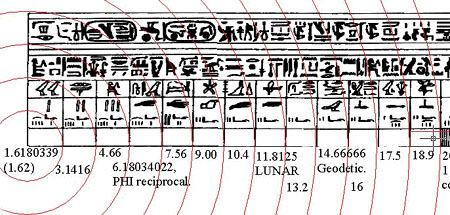
The segments of an Egyptian Royal Cubit of 20.618-inches in length
(as displayed at the Turin museum). The 1st interval is a PHI inch (1-inch
X 1.6180339); The 2nd interval is a PI-inch (1-inch X 3.1416); The 3rd interval
seems to be coded at 4.6656-inches (a very important navigational progression
marked into "The Avenue" at Stonehenge); The 4th interval is a
special PHI reciprocal value that was absolutely essential for the fabrication
of correct (precise capacity) round volume vessels for the ancient market
places... for example: the ancient British Bushel was a round tub with a
base diameter of 3 X 6.18034-inches and straight sides above the base 8-inches
high, giving an exact capacity of 2160-cubic inches); The 5th interval is
navigational (note: the Great Pyramid is 756-feet long), etc.
The Royal Cubit layout seems to have been unsuitable as a rule used in building
work, but functioned more as a specialised calculator and memory device.
Other, more factorable, cubit or foot rules would have been used in construction
work.
(10) 0567 to 0572: The distance is 82.5 and the angle is 37.125-degrees. The distance of 82.5-feet is 1/64th of a mile and the value, used in a mathematical progression, generates a lineup of numbers very useful in navigating by the mile of 5280 feet. Under this system, one minute of arc was 6050-feet, a degree of arc 68.75-miles and the equatorial circumference 24750-miles. The angle of 37.125 would be part of a navigational progression. Other very significant close proximity angles would be 37.5 (lunar and 360-degree compass) & 37.8 (navigation).
(11) 0567 to 0571: The distance is 48.6 and the angle is 45.36-degrees. A mathematical progression based upon 486 is navigational & relates to lunar cycles simultaneously. The angle of 45.36 is navigational. The flat top floor of the Great Pyramid (it never had a capstone) is at a vertical height of 453.6-feet.
(12) 0567 to 0570: The distance is 52.5 and the return angle back to the hubstone is 230.4-degrees. The distance is 1/100th of a Greek Mile and the value is also strongly lunar. The degree angle is navigational. The square foot value for each face of the Great Pyramid @ 8 pyramid acres per face of 28800-square feet each (Herodotus) was 230400-square feet.
(13) 0567 to 0569: The distance is 61.8-feet and the angle is 51.84-degrees. Apart from the 61.8 (PHI reciprocal) value, other dynamic close proximity codes were 62.208 (navigation), 62.5 (navigation) and 63 (navigation and lunar). There would have been mnemonic reference to each in the tutorials related to this position. The angle of 51.84-degrees is both navigational and relates also to the Precession of the Equinoxes. If one travels a sea leg of 1 ancient British league (16500-feet or 3.125-miles), then that linear distance converts (using PI @ 3.141818182) to a circle of 518400-feet (divisible by 360). This modus operandi was similar to the Greek method of linear navigation, where a sea leg of 1-Greek mile (5250-feet) converts to a circle of 1 British league (16500-feet) circumference using PI @ 22/7ths. The slope angle of the Great Pyramid is 51.84-degrees, The base of the Great Pyramid covers 5184-square Reeds (72 X 72 @ 10.5-feet each) and 51.84-years would be 1/500th of the duration of the Precession of the Equinoxes (25920-years or 72 X 360).
(14) 0567 to 0568: The distance is 69.12-feet and the angle is 61.8-degrees. In a world that was 12 X 12 X 12 X 12 X 1.2-miles in circumference (24883.2) the sum of 69.12-miles would be 1-degree of arc. The angle is, again, based upon the very important PHI reciprocal value that was central to fabricating perfect capacity volume vessels for use in market places throughout all the ancient European cousin nations.
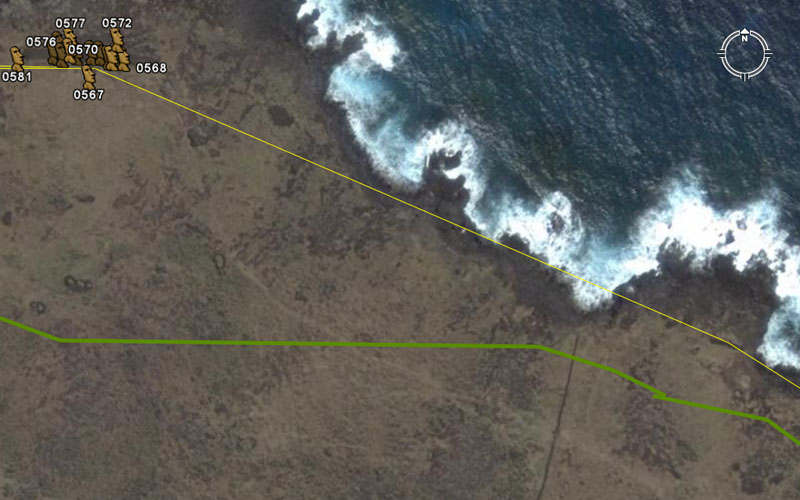
The line from the first ahu platform runs for 1215-feet at an azimuth angle of 113.4-degrees to the second platform down the coast. Although this platform is not marked in the Rapa Nui Archaeological Database, it can be clearly seen in the Google Earth image. Both the distance and the angle to this second platform contain strong lunar and navigational codes:
The distance:
